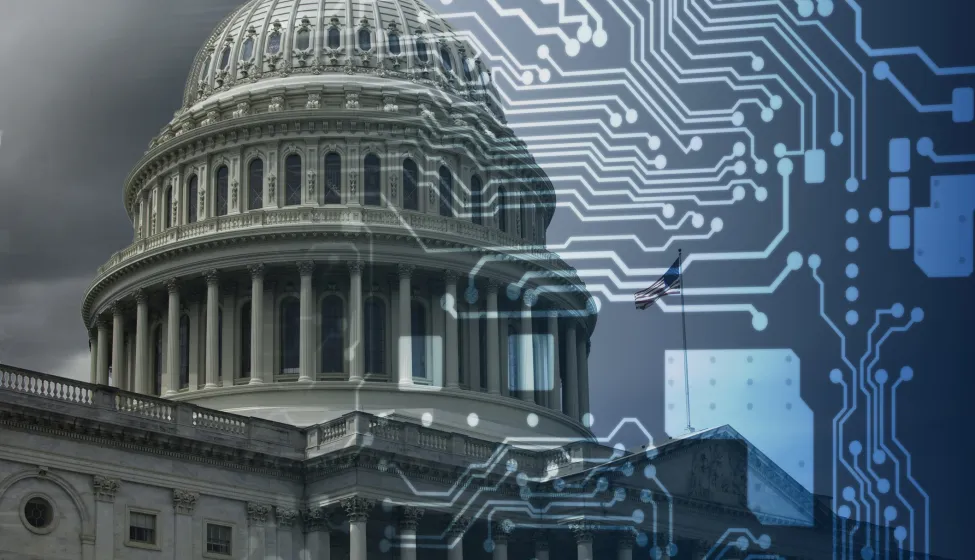July 31, 2025
New federal guidance aims to accelerate and protect U.S. innovation in artificial intelligence
On July 23, the White House released "Winning the Race: America's AI Action Plan," a sweeping policy document outlining the federal government's vision for achieving and sustaining U.S. leadership in artificial intelligence. The plan positions AI as a transformative technology with the potential to ignite new industries, revolutionize scientific discovery, and secure the nation's future in an increasingly competitive global landscape.
This new action plan reflects the latest evolution in U.S. AI strategy, following President Trump's repeal of both the Biden administration's 2023 executive order on "Safe, Secure and Trustworthy AI" and the 2022 White House Office of Science Technology and Policy's "Blueprint for an AI Bill of Rights." The Trump administration's AI Action Plan directly addresses the urgent need for robust innovation, infrastructure expansion, and coordinated international engagement.
What is the White House's AI leadership strategy?
The plan is structured around three fundamental pillars: accelerating AI innovation, building national AI infrastructure, and taking the lead in international AI diplomacy and security. These pillars are designed to operate in concert, matching advances in technology with the necessary physical, regulatory, and diplomatic frameworks.
- Pillar I: Accelerate AI Innovation focuses on removing regulatory barriers, supporting open-source and open-weight AI models, enabling adoption across critical sectors, and empowering American workers through upskilling and education. The plan recommends a government-wide review of existing rules, regulations, and guidance documents with the aim of revising or repealing those that unnecessarily hinder AI development or deployment. There is also a strong emphasis on fostering a pro-innovation environment for private-sector-led advances.
- Pillar II: Build American AI Infrastructure recognizes the need for rapid expansion and modernization of the nation's data centers, semiconductor manufacturing facilities, and energy grid. The plan calls for streamlined permitting, targeted investments in workforce development, and robust cybersecurity measures to support the buildout of next-generation AI systems.
- Pillar III: Lead in International AI Diplomacy and Security aims to project U.S. AI leadership globally, strengthen export controls on critical technologies and semiconductors, and ensure that "American values" shape the global conversation on AI governance and standards.
The plan encourages industry stakeholder coordination with the Department of Defense, the Department of Energy, the National Institute of Standards and Technology (NIST), the Department of Homeland Security, the National Science Foundation, the Defense Advanced Research Projects Agency (DARPA), the Center for AI Standards and Innovation (CAISI), and other organizations to build world-class scientific datasets and AI evaluation ecosystems, protect commercial and government AI innovations, and drive AI adoption across the government.
What are the implications for industry?
The administration's AI Action Plan details actionable recommendations and policy initiatives for federal agencies, many of which have direct implications for the private sector, research organizations, and allied partners.
- Deregulation and Funding Alignment: Agencies are directed to identify and revise or repeal rules that hinder AI progress. Federal discretionary funding for AI is to align with states' regulatory environments, favoring those that foster innovation. The plan recommends establishing new categorical exclusions under the National Environmental Policy Act (NEPA) for data center-related infrastructure; exploring a nationwide Clean Water Act Section 404 permit for data centers; and expediting environmental permitting by streamlining or reducing regulations promulgated under the Clean Air Act, the Clean Water Act, and the Comprehensive Environmental Response, Compensation, and Liability Act (CERCLA, also known as Superfund). The plan then further advances the use of AI to accelerate remaining permitting requirements.
- Open-Source AI and Research Access: The plan strongly endorses open-source and open-weight AI models, with a push to increase access to large-scale computing resources for startups and academics. Public-private partnerships are encouraged to expand research and drive the next generation of AI breakthroughs.
- Build World-Class Scientific Datasets: The plan recognizes the importance of high-quality data, labelling it as a national strategic asset. Agencies are directed to set minimum data quality standards relating to biological, chemical, physical, and other scientific data modalities used in AI training. The plan specifically calls for exploring a "whole-genome sequencing program for life on Federal lands," implying a vast biological data-generating program.
- Workforce Development: The plan prioritizes AI literacy and skills development across educational and workforce funding streams. Initiatives include integrating AI training into career and technical education, expanding apprenticeships, and establishing hubs for AI workforce research and rapid retraining.
- Next-Generation Manufacturing and Science: Investment is targeted at foundational manufacturing technologies, AI-enabled scientific research, and the development of world-class datasets to accelerate discoveries and applications in materials science, biology, and beyond.
- Data centers for Military and Intelligence Usage: DOD, NIST, and CAISI are directed to develop new standards for high-security AI data centers, while other agencies are directed to adopt classified computing environments.
- Cybersecurity and Incident Response: The plan emphasizes proactive cybersecurity strategies, including establishing an AI Information Sharing and Analysis Center and integrating AI into national incident response frameworks.
Global diplomacy, export controls, and security
In the AI Action Plan, U.S. AI leadership is positioned as a cornerstone of national security and global competitiveness, establishing priorities for:
- Exporting American AI technology stacks to allies and partners to prevent strategic rivals from gaining undue influence.
- Strengthening and enforcing export controls on advanced computing and semiconductor manufacturing technologies.
- Aligning protection measures globally, including through new diplomatic initiatives and plurilateral agreements.
- Evaluating frontier AI systems for national security risks, especially in cyber and biosecurity domains.
The plan also mandates the development of robust standards and enforcement mechanisms for the use of AI in sensitive scientific domains, including nucleic acid synthesis, to mitigate biosecurity risks.
What are the policy's guiding principles?
Three foundational principles guide the action plan's execution:
- Empowering American Workers: The federal government frames AI as a tool for augmenting, not replacing, human talent, emphasizing job creation and upskilling.
- Objective and Bias-Free Systems: The plan seeks to ensure federal AI procurement and deployment are free from ideological bias and focused on objective truth and factual analysis.
- Vigilance Against Misuse: There is ongoing investment in monitoring, evaluating, and developing secure-by-design systems to protect advanced technologies from malicious actors and emerging risks.
What Can We Help You Solve?
Exponent's data and computer scientists help clients leverage AI across their operations, with services including building high-quality data sets, model training, validation protocol development, cybersecurity analysis, and red-teaming. Our ecologists and environmental scientists support environmental permitting applications and reviews for data centers and other complex construction and infrastructure projects.

Data Sciences
Acquire, clean, and crunch data for breakthrough insights and informed decision-making.

Cybersecurity Consulting
Identify cybersecurity risks and implement the security controls you need to effectively combat them.

Technology Landscape Review
Extensive IT and technology consulting to help our clients build more sustainable product portfolios.
![DUE DILIGENCE [BES]](/sites/default/files/styles/cards_home_card/public/media/images/GettyImages-1360386685_0.jpg.webp?itok=sC3hx42s)
Technical Due Diligence
Gain a clearer understanding of how your tech assets fit into the wider market landscape.

Environmental Permitting
Extensive support for compliance with local, state, and federal permitting requirements.

Electrical Engineering Services for Data Centers
By supporting the balanced functionality of mechanical and electrical equipment and infrastructure, Exponent primes your facility environment for installation a...
Insights





